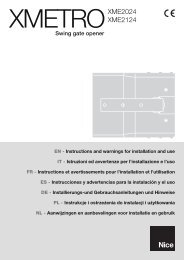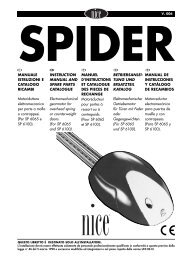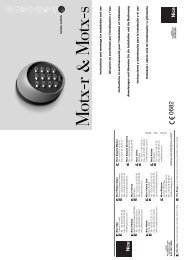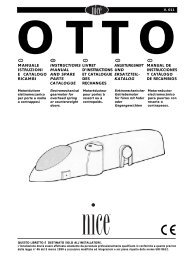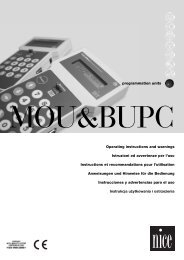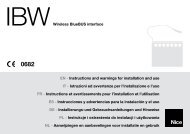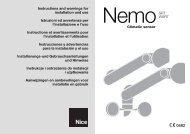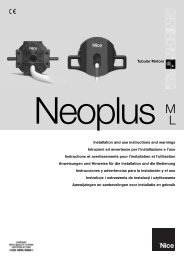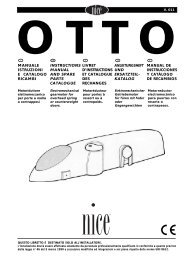Safety measures and warningsThe present manual contains important safety instructionsfor the INSTALLATION and USE of the product.INSTALLATION:Incorrect installation could cause serious injury. For thisreason, all installation instructions contained in the presentmanual should be carefully followed during the working operations.PRODUCT USE:For the safety of persons, it is very important to followthese instructions carefully in the everyday use of the product.Keep this manual in a safe place for future reference.The NEOMAT-A series motors, versions NEOMAT-SA Ø35mm, NEO-MAT-MA Ø45mm and NEOMAT-LA Ø58mm, have been designed for theautomation of rolling shutters and awnings; any other use is consideredimproper and is prohibited. These motors are intended for residentialuse. Maximum continuous operating time is 4 minutes. When selectingthe motor based on the application requirements, the nominal torqueand operating time shown in the rating plate must be considered.The minimum diameter of the tube on which the motor can be installedis 40mm for NEOMAT-SA, 52mm for NEOMAT-MA with torque up to35Nm, 60mm for NEOMAT-MA with torque over 35 Nm and 70 mm forNEOMAT-LA.The motor must be installed by qualified technicians in <strong>com</strong>pliance withcurrent safety regulations.All unnecessary electrical cables must be removed before installation; allmechanisms not required for motorized operation must be disabled. Ifthe motor is installed at a height below 2.5m, all moving parts of themotor must be protected. For awning applications, the horizontal clearancebetween the fully open awning and any stationary object must beat least 0.4m.The PVC power supply cable supplied with NEOMAT-A motors is idealfor internal installation; an insulated tube must be used to protect thecables when installed outside, or the specific S05RN-F type cable canbe requested.The tubular motor must not be subjected to crushing, impacts, falls orcontact with any kind of liquid. Do not perforate or drive screws into anypart of the tubular motor; see figure 1. The control switch must be fixedin an easily visible location but away from moving parts and at a heightno less than 1.5m. Do not modify any <strong>com</strong>ponents unless such action isspecified in these instructions. Operations of this kind are likely to leadto malfunctions. NICE disclaims any liability for damage resulting frommodified products.For maintenance and repairs contact a qualified technician.When the roller shutter or awning is in movement, make sure that thereare no persons within the movement range. Do not activate the awningif work is being carried out close by, for example: window cleaning; incase of automatic control, disconnect the power supply as well. Do notlet children play with the fixed control device and keep the remote controlsout of their reach. Check the balancing springs (if any) and the wearof cables at frequent intervals.If the slope of the awning is less than 25% or less than thevalue re<strong>com</strong>mended by the manufacturer it should be retractedto avoid water pockets when it rains.The rolling shutter could be damaged if used when ice hasformed.Some of the programming phases can use the mechanicalstops of the roller shutter (caps and/or burglar-proof springs).In this case it is necessary to select a motor with a torque thatis suitable for the application taking into consideration theeffective stress and avoiding excessively powerful motors.1) Product descriptionThe NEOMAT-A series motors, versions NEOMAT-SA Ø35mm, NEO-MAT-MA Ø45mm and NEOMAT-LA Ø58mm, are electric motorsequipped with RPM reduction and terminating at one end with ashaft on which the driving wheels can be mounted; see figure 2. Themotor must be fitted inside the winding tube, where it can raise orlower the roller shutter or awning.The control unit incorporated in the motor also has a high precisionelectronic limit switch system that can constantly detect the positionof the rolling shutter.The movement limits, roller shutter or awning open and roller shutteror awning closed (as well as intermediate positions), can be programmedand the awning automatically stops when these positionsare reached.The NEOMAT-A series motors incorporate a radio receiver operatingat a frequency of 433.92 MHz, with rolling code technology thatguarantees high levels of security. It is possible to memorize up to 14transmitters for each motor in the ERGO, PLANO and NICEWAYseries; see figure 3; that allow the remote control of the motors, or 3wind and sun radio sensors “VOLO-S-RADIO” which control themotor depending on the weather conditions.The programming of the limit switches and additional functions canbe done directly from the transmitters, with beeps that sound toguide users through the various phases. It is also possible to controlthe motors via an external button (using the Step-by-Step function)or “TTBUS” Bus. A F210S photocell, which detects the presence ofpossible obstacles preventing the lowering manoeuvre, can be connectedon the TTBUS as an alternative to the Step-by-Step button.For more details, see the F210S photocell instructions (on NEOMAT-MA and NEOMAT-LA only).Optional wind, sun and rain sensors can be connected to the weathersensors input that automatically activate the motor when theweather conditions require.The input of the sensors can also be used (as an alternative to theweather sensors) to connect an 8.2KΩ constant resistance sensitiveedge in order to guarantee the safe operation of the automationwhen required.2
2) InstallationIncorrect installation could cause serious injury.Proceed as follows to prepare the motor:1. Position the limit switch crown (E) on the motor (A) until it fits into the correspondinglimit switch ring (F); make sure that the two grooves match. Push it into position asshown in Fig. 5.2. Mount the drive wheel (D) on the motor shaft.On NEOMAT-SA the drive wheel (D) snaps on automatically.A: NEOMAT-A Tubular motorB: Fastening clips or split pinsC: Support and spacerD: Draw lock ringE: Idle lock ringF: Idle ring3. On NEOMAT-MA fasten the drive wheel with the snap ring. On NEOMAT-LA fasten the drive wheel with the M12 nut and washer.4. Fit the assembled motor into the winding roller until the crown (E) is fully inserted. Fasten the drive wheel (D) to the winding roller usingthe M4x10 screw, so as to prevent the motor from slipping or sliding axially (fig. 6).5. Finally, secure the motor head to the special support (C) with the spacer (if any), using the clips or split pin (B).GB2.1) Electrical connectionsFor motor connections, an omnipolar disconnectingdevice with a 3-mm minimum distance between contactsmust be provided for disconnection from the mains powersupply (disconnecting switch or plug and socket, etc.).Carefully follow all the connection instructions, if youhave any doubts do not make experiments but consult therelevant technical specifications sheets which are alsoavailable on the web site www.niceforyou.<strong>com</strong>.An incorrect connection may be dangerous and causedamage to the system.The cable used for the electrical connections of the NEOMAT-SA,NEOMAT-MA and NEOMAT-LA motors has 6 wires; 3 of the wires(yellow tag) are for the mains power supply and 3 wires (green tag)are for the <strong>com</strong>mand signals.For the electrical connections see the diagram below. The connectiondevices are not supplied with the product.Yellow labelLNWire colouring:Mains power supplyBrown = PhaseBlue = NeutralYellow/Green = EarthGreen labelCommand signalsBlack/White = Common (0V) White= Step-by-St. + “TTBUS” orF210SOrange/White = Weather sensors or 8.2KΩresistive edge2.1.1) Mains power supply (Brown + Blue + Yellow/Green):The mains power supply must be connected to the following wires: Brown (Phase); Blue (Neutral) and Yellow/Green (Earth).Do not connect the mains power supply (230V or 120V) to the other wires.2.1.2) “Step-by-Step” input (White + Black/White):To manually <strong>com</strong>mand the automation system, a simple button can be connected between the White wire (Step-by-Step input) and theBlack/White wire (Common).The operating method follows the sequence: up-stop-down-stop.If the button is kept pressed for more than 3 seconds (but less than 10) an up manoeuvre is always carried out (corresponding to the ▲ buttonon the transmitters). If the button is kept pressed for more than 10 seconds a down manoeuvre is always carried out (corresponding tothe, ▼ button). This function can be used to “synchronise” multiple motors to carry out the same manoeuvre, regardless of their operatingstatus.2.1.3) “TTBUS” input (White + Black/White):“TTBUS” is a Bus that was developed to control individually motors or control units, up to 20 devices by simply connecting them in parallelwith just 2 wires. Further information is contained in the instructions for the remote controls via “TTBUS”.The TTP or TTI programmers can be connected to the TTBUS input making the system management and programming operations easier;for further information, consult the related manuals.3



